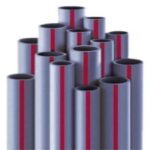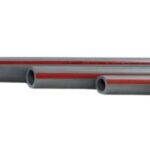Discover Excellence in Every Product
Pipes



CPVC vs UPVC: Understanding the Differences
Material Comparison | January 17th, 2021
PVC is a highly versatile material used in **piping, electrical casing, drug delivery tubing, and food packaging**. In this article, we’ll explore the key differences between **UPVC and CPVC** and why **CPVC is the superior choice** for **residential, commercial, and government projects**.
What is UPVC?
UPVC (Unplasticized Polyvinyl Chloride) is a rigid form of **PVC** that is widely used for **water supply, drainage, electrical conduits, and industrial piping**. Unlike traditional PVC, UPVC does not contain plasticizers, making it more durable and less flexible.
Applications of UPVC Pipes
- Potable Water Supply: Used in domestic and industrial plumbing (IS 4985, IS 12818, IS 12231).
- Drainage Systems: Suitable for soil waste drainage (IS 9721, IS 12592).
- Electrical Conduits: Commonly used for protecting wiring in buildings.
- Industrial Use: Ideal for chemical transportation.
Limitations of UPVC
- Not all UPVC grades are safe for potable water.
- Cannot withstand **hot water temperatures**.
- Some manufacturers exceed **filler limits**, making pipes brittle.
- Limited **UV stability**, making it prone to aging.
What is CPVC?
**CPVC (Chlorinated Polyvinyl Chloride)** is a modified version of PVC with increased **chlorine content (63-67%)**. This makes it a **more stable, heat-resistant, and durable polymer**. CPVC is lead-free and is globally approved for potable water use.
CPVC vs UPVC: Key Differences
Feature
UPVC
CPVC
Temperature Resistance
Cold Water Only
Hot & Cold Water
Potable Water Approval
Limited
Globally Approved
UV Stability
Low
High
Suitability for External Use
Limited
Yes
Why Choose CPVC?
- Suitable for **hot & cold water piping**.
- Has **global potable water certifications**.
- Higher **UV stability**, suitable for both **indoor & outdoor** applications.
- Stronger **chemical and impact resistance**.
Trusted CPVC Brands: FlowGuard® Plus by Lubrizol
**Lubrizol invented CPVC in 1959** and supplies CPVC compounds under the **FlowGuard® Plus** brand, ensuring **quality and durability**. It is manufactured in India by **Ashirvad Pipes Pvt Limited** and **Prince CPVC Pipes & Fittings Limited**.
Choose CPVC for a trouble-free plumbing system that lasts for years!
CPVC vs UPVC: Understanding the Differences
Material Comparison | January 17th, 2021
PVC is a highly versatile material used in **piping, electrical casing, drug delivery tubing, and food packaging**. In this article, we’ll explore the key differences between **UPVC and CPVC** and why **CPVC is the superior choice** for **residential, commercial, and government projects**.
What is UPVC?
UPVC (Unplasticized Polyvinyl Chloride) is a rigid form of **PVC** that is widely used for **water supply, drainage, electrical conduits, and industrial piping**. Unlike traditional PVC, UPVC does not contain plasticizers, making it more durable and less flexible.
Applications of UPVC Pipes
- Potable Water Supply: Used in domestic and industrial plumbing (IS 4985, IS 12818, IS 12231).
- Drainage Systems: Suitable for soil waste drainage (IS 9721, IS 12592).
- Electrical Conduits: Commonly used for protecting wiring in buildings.
- Industrial Use: Ideal for chemical transportation.
Limitations of UPVC
- Not all UPVC grades are safe for potable water.
- Cannot withstand **hot water temperatures**.
- Some manufacturers exceed **filler limits**, making pipes brittle.
- Limited **UV stability**, making it prone to aging.
What is CPVC?
**CPVC (Chlorinated Polyvinyl Chloride)** is a modified version of PVC with increased **chlorine content (63-67%)**. This makes it a **more stable, heat-resistant, and durable polymer**. CPVC is lead-free and is globally approved for potable water use.
CPVC vs UPVC: Key Differences
| Feature | UPVC | CPVC |
|---|---|---|
| Temperature Resistance | Cold Water Only | Hot & Cold Water |
| Potable Water Approval | Limited | Globally Approved |
| UV Stability | Low | High |
| Suitability for External Use | Limited | Yes |
Why Choose CPVC?
- Suitable for **hot & cold water piping**.
- Has **global potable water certifications**.
- Higher **UV stability**, suitable for both **indoor & outdoor** applications.
- Stronger **chemical and impact resistance**.
Trusted CPVC Brands: FlowGuard® Plus by Lubrizol
**Lubrizol invented CPVC in 1959** and supplies CPVC compounds under the **FlowGuard® Plus** brand, ensuring **quality and durability**. It is manufactured in India by **Ashirvad Pipes Pvt Limited** and **Prince CPVC Pipes & Fittings Limited**.
Choose CPVC for a trouble-free plumbing system that lasts for years!

Hafiz Plastic Factory
We respect your choice, Plastic Product's Manufacturing
Opening Hours
- Office :Sat - Thu: 8:00 am to 8:00 pm
- Production : Sat - Thu: 24 hours
- Friday: Closed
